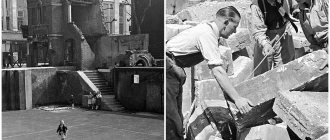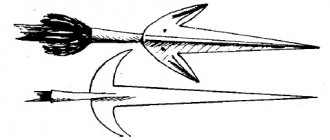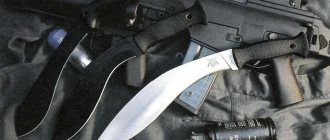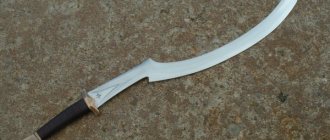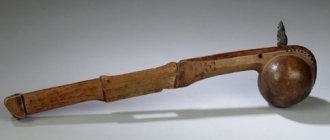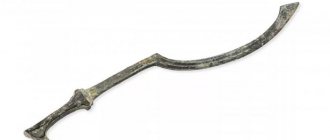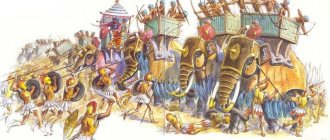The standard SS daggers for members of security detachments, the Schutzstaffel (SS), were introduced in 1933 by a separate order, according to which all members of the detachment were required to wear them. The order was signed by the acting chief of staff of the SA, Obergruppenführer von Krausser. In general, the SS accepted only persons who had reached the age of 21, who had to undergo tests for a period of more than one and a half years, testing beliefs, loyalty, and unquestioningness. Representatives of this powerful body were distinguished by black military uniforms and represented the elite of the Nazi regime.
SS dagger, exact copy in modern design
The first samples of SS daggers
The first SS daggers completely copied the standard SA daggers of the 1933 model, but differed only in the color of the handles and sheaths to maintain the style of the uniform. The SS daggers of the 1933 model were decorated with the organization's emblem. The emblem looked like two lightning-stylized “S” letters at the top of the black hilt, and the blade was also engraved with the SS motto (“Meine Ehre heist Treue” - “My honor is called loyalty”).
At first, the first SS daggers had parts with a metal nickel silver finish, and the scabbard was finished with oxidized iron. However, later the scabbard linings began to be made of nickel-plated iron, and the pommel of the dagger handle with elements of the guard were made of nickel-plated zinc or aluminum. The Nazi eagles on the handles, holding the swastika in their claws, were also plated with nickel or were entirely zinc or aluminum. Lanyards made from a standard silver 42-cm cord for SS daggers were allowed to be worn exclusively by special officers.
The first models of edged weapons of German troops
Modern reconstructions of the SA dagger have no historical value.
In the army of Nazi Germany, there were many branches of the army and combat formations, each of which had its own distinctive insignia. Cold steel is one of the main attributes of belonging to a particular military unit. SA assault troops were the first to carry daggers.
After the start of serial production, the standard SA dagger of the 1933 model gained popularity among military and civilians who supported the ideas of fascism. The knife cost 8.40 Reichsmarks and was sold on credit. Features of the SA dagger:
- The blade is double-edged;
- The knife is made with a predominance of brown shades, since the SA form was exactly that color;
- On one side of the dagger is the inscription “Alles fur Deitschland” (“Everything for Germany”);
- On the reverse side of the blade is the manufacturer's mark.
The SS dagger appeared in the same year. It is made in black, matching the color of the SS uniform. The knife has the same dimensions as the SA version. The main difference, besides the black color of the wood on the handle, was the inscription “Meine Ehre heisst Treue” (“My honor is called loyalty”) engraved on one side of the blade, and the manufacturer’s mark and year of manufacture on the other.
Basic parameters of bladed weapons of the Third Reich - SS daggers
SS daggers are mainly distinguished by their:
- Length in sheath – 360–375 mm;
- Length without sheath – 345–350 mm;
- Double-edged blade;
- Length – 220–230 mm;
- Width – 34–35 mm;
- Thickness at the heel – 5.5 mm;
- Handle;
- The length of the wood part is 110 mm;
- Width – 35 mm;
- Thickness – 21 mm.
The SS ceremonial dagger of 1933 had three types of suspension systems, which were mainly used during ceremonial marches:
- Standard carabiners on leather straps with round buckles;
- With additional holders, which are straps with buttons;
- Rarely found vertical pendants, which were put on a sheath and had carabiners on the reverse side.
Schutzstaffel (SS) dagger 1933
The SS men were given daggers in a festive atmosphere when SS-Anwaerter (SS candidates) became SS-Mann. The loss of SS service daggers entailed strict disciplinary action; as a result, these models are rarely found as collectible weapons. The daggers cost 8.40 Reichsmarks, and all future owners paid for their “relics” personally.
In 1934, the head of the SS-Amt, Kurt Wittje, banned any open sale of SS daggers and dirks. And this despite the fact that other services of Nazi Germany traded cold weapons openly and without any restrictions. In 1935, the markings I, II and III began to be stamped on the reverse side of the hilt of SS daggers. This marking designated one of three special centers that were responsible for issuing SS weapons in the cities of Munich, Dresden and Berlin.
Elite attribute of German officers
The ban on the sale of SS daggers in 1934 made these weapons part of the uniform ammunition of the SS. On
February 17, 1934, Gruppenführer Kurt Wittier, the head of the SS Directorate, banned the free sale of the official edged weapon of the Third Reich - the SS dagger. The knife with a handle in the original black lacquer color could only be purchased through SS structures. Sales were carried out through three main uniform production centers in the cities:
- Dresden;
- Munich;
- Berlin.
In 1935, a special decree came into force, according to which every dismissed SS man was obliged to hand over his SS service dagger to the party representative. In case of resignation due to age or voluntary departure, the former employee received a special document giving the right to legally own these bladed weapons.
The most famous knife workshops in Germany produced these blades:
- "Böcker and Co";
- Richard Herder;
- Carl Eichhorn;
- Robert Klaas and others.
The first models of SS daggers, produced from 1933 to 1935, had the master's mark.
Markings on the blades of SS daggers
The markings on the blades of SS daggers could be something like this:
RZM М7/66/33, where:
- RZM – (designation of the Nazi control service (Reichszengmeistrei));
- M – designation that the knife blade is made of metal;
- 7 – designation of a type of product from the manufacturer itself (in this particular case, this is the designation of bladed weapons of the Third Reich);
- 66 – designation of the code of the manufacturing enterprise (in this case, the products were manufactured at an enterprise owned by Karl Eikhorn);
- 33 – designation of the year of production.
SS dagger - edged weapon of Nazi Germany
In addition, when the daggers were state property, they were branded - on the back of the hilts of senior officers and on the sides of the guards of daggers belonging to junior SS officers. After dismissal or expulsion during the process of surrendering weapons, these alphanumeric designations were destroyed. When retiring, the SS men had the right to keep the daggers for themselves, which was confirmed by separate documents. SS daggers were produced until 1942.
The history of the appearance of Waffen-SS blades
The original SS daggers were copied from traditional Swiss hunting blades.
The Nazis were very proud of their past, tracing it back to the ancient German tribes, so they chose the Holbein hunting dagger as a bladed weapon for the assault troops. The blade received its name thanks to a painting by Hans Holbein the Younger, written in the 16th century, which depicted a classic Swiss dagger for hunting, which the Nazis liked. Several interesting facts related to the appearance of this bladed weapon:
- The blade shape of the SS dagger copied ancient Roman swords;
- The scabbard, suspension, handle and other design elements were developed in Munich, which is not the center of production of bladed weapons in Germany. Most of the world famous knife workshops were located in Solingen;
- The dagger in its final form was finalized by Professor Schmidt at the Munich School of Art.
The final version of the bladed weapon was approved by SA Oberführer von Karlshausen.
SS service daggers, model 1936
The SS daggers of the 1936 model are almost one hundred percent identical to the standard daggers of 1933. Their only difference is a slightly modified scabbard suspension system. The daggers were intended for all SS officers who joined the elite organization of the Third Reich after November 9, 1935, as well as for all who had already served for at least three years before the end of January 1936.
The design of the sheath hangers for the new SS daggers was done by Karl Diebitsch. Such pendants were flat metal chains consisting of alternating skulls with the emblems of this structure - SS sigruns (“lightning bolts”, signifying the victory of good forces over evil). In addition, there were a pair of plates in the upper parts of the chains, and four in the lower parts. In the middle of the scabbard, metal inserts appeared, on which there were stylized relief swastikas, to which the lower edges of the pendant chains were attached. Carbines for wearing were decorated with ancient German armor ornaments - clover leaves.
The blade of the SS knife was engraved with the motto (“Meine Ehre heist Treue” - “My honor is called loyalty”)
Chains with carabiners in the first models were nickel, but later they began to use cheaper materials in their production, and nickel itself was only used as a coating.
Initially, it was assumed that the new SS daggers would be worn exclusively with the black SS uniform. However, since 1943, officers of the Waffen SS troops received permission to wear lanyards, and this despite the fact that they were worn only with a gray uniform. Thanks to this, the SD (security service) was the only SS structure that had lanyards on its daggers. Moreover, it became possible to purchase SS daggers at specialized retail outlets, with the prior approval of RZM.
SS elite unit of the Third Reich
A small organizational unit was created in 1925 to provide personal protection and security for Adolf Hitler. The formation did not have much influence until 1929.
With the arrival of Heinrich Himmler, the SS began to differ:
- power and independence;
- control over the state police;
- ruthless and principled decisions.
At first the SS was part of the SA units. Later the unit became autonomous. There were several conditions for admission:
- age not younger than 21 years;
- completion of a probationary period of at least 18 months;
- testing of beliefs, loyalty, unquestioningness;
- good physical fitness.
The SS is considered the most brutal and hated formation of the Third Reich.
SS award daggers with Himmler's personal signature
When in June 1934, during the “night of long knives,” one of the SS commanders, Ernst Rehm, who was disloyal to Adolf Hitler, was eliminated, then 200 stormtroopers were counted as particularly distinguished. They were actively liquidating Rem together with his associates. This entire group was awarded an extremely rare edged weapon today - SS daggers with the personal signature of Heinrich Himmler. On the daggers was written: “In herzlicher Freundschaft. H. Himmler”, which translates as “As a sign of cordial friendship. G. Himmler").
SS award dagger, model 1933, personally signed by Heinrich Himmler.
This inscription was a repetition of the inscription on the commemorative SS award daggers with which the first members of the organization were armed. All I had to do was replace Rem’s signature with Heinrich Himmler’s signature. All such daggers were numbered in the lower parts of the second hilts (200 numbers in total). In all other respects, the SS award daggers of the 1934 model with Himmler’s personal signature repeat the standard SS daggers of the 1933 model. This also applies to the inscriptions on the front side of the blades, to the color design, to the suspension systems and to the decorative elements.
SS daggers
The "service" or "uniform" SS dagger (SS-Uniformdolch), with nickel-plated guard and hilt, was introduced by order No. 1734/33 of December 15, 1933, signed by the acting chief of staff (staff chief) of the NSDAP assault troops, SA Obergruppenführer von Krausser (since at the time described the SS was still formally included in the SA). In appearance, the SS dagger of the 1933 model was completely identical to the standard SA dagger of the 1933 model, differing from it only in the color of the handle and sheath. Since by the time described the SS uniform was not brown (like the SA ranks), but black and silver, the sheath and handle of the SS dagger were also designed in a black and silver color scheme. It should be noted that the shape of the SS daggers, as well as the SA and NSKK (National Socialist Motorized Corps) daggers, was identical to the shape of the so-called “Schweitzerdolch” - a Swiss (and not “Swedish”, as is sometimes incorrectly written and thought!) dagger of the Renaissance era (or rather, the second half of the 16th century)
———————————————
The SS dagger of 1933 should not be confused with the SS “honorary” or “reward” dagger introduced later. The middle of the wide spear-shaped blade was decorated with the inscription “My honor is called fidelity” in Gothic letters.
: Meine Ehre heisst Treue), which was the motto of the SS. In the middle of the handle, made of ebony (ebony) wood or bog oak, there was a silver eagle with outstretched wings and a hook-shaped cross in its claws, and above the eagle, just under the hilt, there was a double silver rune “sig” (“sovulo”), inscribed in a circle of black enamel with a silver rim. The dagger's scabbard, made of blued or shiny black lacquered metal, had a silver-plated metal finish (as opposed to the brown-silver finish of similar SA daggers). For SS daggers of the 1933 model, 3 types of suspensions were introduced. The 1st, standard, version of the suspension was a carbine on a leather strap with a round silver clasp; The second version of the suspension, equipped with a holder, was similar to the previous one, but a strap with a metal button was attached to the leather mount located on the belt, which fixed the handle of the dagger in a relatively stationary position; The 3rd version of the suspension consisted of 3 parts, was put directly on the sheath and had a carabiner on the reverse side. A lanyard (German: Portepee) for a dagger, made of silver thread, was allowed to be worn only by authorized representatives of the SS command (Führer) staff. Along with the above 3 types of pendants, “non-statutory” examples of pendants have also been preserved, in the colors of the black, white and red “national” flag of Germany with the black SS double rune “Sig” (“Sovulo”), inscribed in a black ring. Every year on November 9, on the anniversary of the “March to the Feldgerrnhalle”, during a solemn ceremony by torchlight, this service (“uniform”) dagger was awarded to each candidate for the SS (SS-Anwerter), accepted into the ranks of the SS as a full member of the Schutzstaffel (SSman). ). In 1940, the production and delivery of “service” (uniform) SS daggers was stopped “until the end of the war.”
About the SS award dagger of the 1934 model
The SS award dagger model 1934 was awarded to Fuhrers, Unterfuhrers and SS privates who joined the ranks of the Schutzstaffel before December 31, 1931. In appearance, it completely replicated the standard SS dagger of the 1933 model. However, on the back of its blade was engraved the inscription “As a sign of cordial friendship. Ernst Röhm). The fact is that this dagger was awarded to distinguished SS ranks (still formally part of the SA) by the SA chief of staff Ernst Röhm. After the removal of Röhm by the ranks of the “Leibstandarte Adolf Hitler” under the command of “Sepp” Dietrich on the bloody “Night of the Long Knives” on June 30, 1934, according to the order of the Reichsführer (Imperial Leader) SS Heinrich Himmler dated July 4, 1934, the owners of “Röhm’s” daggers were ordered erase the inscription that has become “seditious” from the back of the blade, or replace the “Rem” dagger with a standard “uniform” SS dagger. It must be said that the members of the NSDAP assault troops who survived the “Night of the Long Knives” are also the Night of the Long Knives.” This so-called “Himmler” SS award dagger, ironically (or perhaps intentionally!) was identical in appearance to the “Röhmler” SS dagger, with the exception of the inscription on the back of the blade, where Ernst Röhm’s signature was replaced by Heinrich Himmler’s signature (“As a sign of cordial friendship. Heinrich Himmler”). At the bottom of the hilt the serial number of the owner of the award dagger was affixed. About the SS dagger of the 1936 model The SS dagger of the 1936 model was awarded to all SS Fuhrers who joined Schutzstaffel after November 9, 1935, as well as to all SS ranks, regardless of rank, who had served in Schutzstaffel for at least 3 years by January 30, 1936. In appearance, it completely repeated the standard “uniform” SS dagger of the 1933 model, with the exception of the design of the scabbard, which was attached to the waist belt not with a leather suspension, but with a metal chain of flat octagonal links with alternating images of the 2 main emblems of the SS - “dead heads" and double runes "sig" ("sovulo"). In addition, the scabbard of the SS dagger of the 1936 model was additionally decorated in the middle with a silver metal insert with the image of a swastika meander, intended for attaching the lower part of the chain. The fastening carbine was covered with a decorative 8-petal slotted rosette, made in the style of ornament characteristic of forged German knightly armor of the late Middle Ages. This dagger existed in several varieties. An earlier version had an oxidized scabbard with nickel silver scabbard elements, a chain and parts of the hilt. Later versions had a scabbard painted black (less often oxidized), nickel-plated iron scabbard parts and chain, zinc or aluminum guards. Since 1943, Waffen SS Fuehrers were allowed to wear a standard silver lanyard on the hilt of their dagger (similar to the standard silver lanyard worn on the officer's dagger of the German Wehrmacht ground forces).
About the “honorary” SS dagger of the 1936 model
On June 21, 1936, an “honorary” dagger (“Erendolch”) of a new type was introduced, intended to award Schutzstaffel unterfuhrers and Fuhrers who joined the ranks of the SS even before Hitler came to power on January 30, 1933. The award dagger itself was identical to the “uniform” dagger model 1933, but its silver-plated hilt and guard were decorated with an ornament of oak leaves. The dagger's scabbard, covered in black leather, was decorated at the top and bottom with silver plates decorated with convex patterns of oak leaves. The silver-plated hilt and guard of the dagger were also decorated with patterns of oak leaves. On the front side of the blade of the dagger, made of Damascus steel, the SS motto “My honor is called fidelity” was stamped in gold, made in Gothic letters and framed on both sides by a gold image of a bunch of 3 oak leaves. The dagger was supposed to be worn suspended from the belt on a silver-plated metal chain of flat octagonal links, on which (as on the neck gorgets of SS standard bearers) engraved images of the 2 main emblems of Schutzstaffel alternated - the double rune “sig” (“sowulo”) and “ dead heads." At the point where the chain was attached to the waist belt there was a special clip in the form of a 4-petal openwork rosette. On February 15, 1945, Waffen SS Führers who were awarded the "dagger of honor" were allowed to wear this dagger with their feldgrau uniform. In this case, an officer's lanyard (Portepee) made of silver thread, similar to the lanyard that officers of the German Wehrmacht wore on their daggers with their uniform, was attached to the handle of the dagger.
About gift and award daggers of the Reichsführer SS
Along with the standard SS daggers of the 1933 and 1936 models described above, which were mass-produced, there were also various options for gift and award daggers, manufactured strictly individually and in individual execution. Gift daggers purchased at their own expense were awarded as a sign of recognition of merit at the level of individual units. In some cases, honorary daggers were awarded to those who distinguished themselves personally by Reichsführer SS Heinrich Himmler. The first type of “honorary dagger”, made for the first time in 1934, did not yet differ from the standard “uniform” dagger in anything other than the inscription “As a sign of cordial military camaraderie. G. Himmler" engraved on the back of the blade. Another type of "dagger of honor", first made in 1936, was distinguished by the presence of a scabbard covered in black leather, trimmed with silvered oak leaves. The hilt and guard of the dagger were also decorated with an oak leaf design, the blade was made of hand-forged Damascus steel, and the SS motto “My honor is called fidelity” was embossed on the blade in gold letters and framed with gold chased oak leaves. It should be noted that, although the “honorary (award) daggers of the Reichsführer SS” described above (contrary to widespread, but no less erroneous ideas) were not intended exclusively for awarding ranks of the SS, some generals and Fuhrers of the Waffen SS were awarded these honorary edged weapons from the hands of Heinrich Himmler himself.
About the daggers of the SS Postal Guard
After Adolf Hitler came to power in 1933, the German Postal Guard (Deutscher Postschutz) was established, designed to guard and protect postal institutions, nodes and communications in the territory of the Third Reich (since at the time described, all imperial communications, including telephone and telegraph services , were under the jurisdiction of the postal service). All postal employees were government officials, were members of the SS or SA and were subordinate to the Postmaster General, Dr. Ohnesorge. In March 1942, the Postal Guard was, with the consent of Adolf Hitler, included by Heinrich Himmler in the “General Purpose SS (Allgemeine SS)” and renamed the SS Postal Guard (SS-Postschutz). In 1939, the Postal Guard Dagger (PS-Dolch) was established for the command (Führer) staff of the Postal Guard (Postschutz, German abbreviation: PS), commanders of special teams (Sonderkommandos) of the postal guard and heads of post offices. The handle of the “postal” dagger was made of wood and painted black. The metal parts of the handle and sheath were nickel-plated, without engraving or any decorations. In the center of the handle was the logo of the Postal Guard in the form of the NSDAP party eagle with outstretched wings, clutching a hook-shaped cross and a bunch of lightning bolts in its claw. The dagger's guard was made in the shape of an eagle's head. The straight crosspiece of the dagger was made in the shape of outstretched stylized eagle wings. In the middle of the cross there was (on both sides) a round medallion with an image of a rotating rotor in black enamel on a gold field. As a suspension for attaching the sheath of the Postal Guard dagger, covered with black leather and decorated with silver-plated smooth overlays, to the waist belt, there was a silver metal chain, consisting of 2 parts: the upper one - of 9 ring-shaped links and the lower one - of 12 links, with a silver metal carbine attached to the center of the chain. A lanyard made of silver threads with orange or red threads woven into it was worn with the dagger.
Stormtrooper Dagger
Nazi Red Cross dagger
National Socialist Flying Corps dagger

